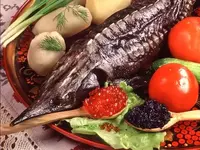Moscow

Old Moscow or Moscow cuisine began to develop in the 17th century. The impetus for the separation of Moscow cuisine from Old Russian was the war with the Swedes and Poles. The next quarter century after the end of the war was a time of great change for all of Russia.
The peasantry rebelled due to overwhelming taxes and difficult post-war living conditions. It was at this time that there was a sharp separation of the culinary traditions of the common people and the nobility. Previously, the nobles' meal consisted of a large number of dishes.
For the upper class, wines and fruits were specially brought from abroad, mainly dried fruits. However, the recipes of Moscow cuisine were uniform both for the nobility and for the peasants. With the separation of Moscow cuisine from Old Russian, the usual order and way of life in everyday and festive meals has changed.
Now the dishes of Moscow cuisine were available only to nobles. At the turn of the XVII century, the rapid and rapid development of foreign economic relations of Russia with neighboring states began.
The nobles had a great opportunity to acquire overseas treats. In contrast, ordinary people could afford a rather scarce and just a set of necessary products. Depending on the territory of residence of people, local cuisines of certain regions of Russia began to arise and form.
That's what's really interesting. Any dish of Moscow cuisine that the Tsar himself and his entourage could taste could be tasted by any Russian person. All the ingredients were on sale, and tsarist cooks and other servants could willingly share the recipes of Moscow cuisine. In addition, even the most exotic spices and spices could be purchased from merchants. The only question was price.
At that time, Moscow cuisine was available not only at the court of the Tsar and in the capital itself. Moscow cuisine recipes went beyond Moscow and migrated to the culinary traditions of the Moscow region. Moscow cuisine was able to keep its position in the flesh until the beginning of the 20th century. The traditions of Moscow cuisine are especially well preserved in Zamoskvorechye.
From the XVII to XX centuries in Russia, several independent culinary directions were co-ordinated, and traditional dishes of Moscow cuisine continued to cook. The main feature of Moscow cuisine can be considered not only rich dishes of nobles and the Tsar.
The meal itself became held according to certain rules. Moreover, the royal feast was strikingly different from the holidays of the ordinary nobility. Nobles began to compile a special list, which was called the painting of meals. Now the cook who served with the nobleman knew that he had been cooking for a whole year for the master.
The noble meal began to consist of even more dishes, sometimes in one meal the servant replaced 50 dishes. The royal receptions were even more diverse, the number of subjects of royal dishes reached 200 pieces per feast.
To further enhance the effect of Moscow cuisine, chefs began to choose the largest game, fish or piglet for royal treats. Then it really seemed that the tables were just breaking from the dishes, and the wine was pouring a river. The usual royal feast at that time lasted at least 8 hours.
At the same time, the diet of ordinary people is becoming more modest. It is from Moscow cuisine that recipes for Balkan and Asian cuisine begin to penetrate into the Russian culinary tradition. The perfect meal of Moscow cuisine of those times was a whole piece of poultry or animal baked over an open fire.
 Español
Español Français
Français Português
Português Русский
Русский 简体中文
简体中文 繁體中文
繁體中文 日本語
日本語 한국어
한국어 العربية
العربية Türkçe
Türkçe Қазақ
Қазақ Deutsch
Deutsch Italiano
Italiano Українська
Українська
